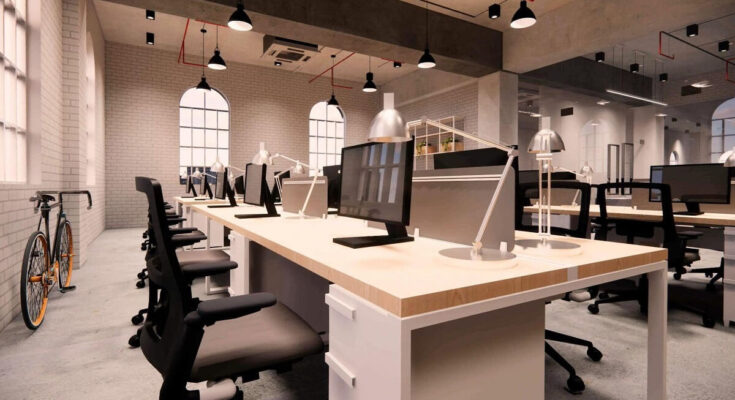Deciding to renovate an office space can significantly impact a company’s morale, productivity, and overall success. Usually, office renovations aim to modernize the workspace, accommodate growth, or improve functionality. Office renovations determine the future of your business. In this article, we will delve into some of the common reasons for undertaking office renovations and provide tips on estimating the time required to complete the project.
A well-planned renovation guarantees minimal disruption while maximizing long-term benefits for employees and clients alike. Commercial-NDS is a well-known construction company in Alberta that provides 24-hour emergency solutions to repair damage.
Common Reasons for Office Renovations
Following are some common reasons that lead to office renovations:
1) Improving Employee Productivity and Comfort
The main reason companies choose to renovate their office spaces is to make a more comfortable and productive environment. To improve employee well-being and efficiency modern offices are designed with natural lighting, open layouts, and areas dedicated to collaboration.
For instance, offices that have been updated with better temperature and lighting control can significantly reduce employee exhaustion. Apart from this, open spaces encourage teamwork and innovation.
2) Accommodating Business Growth
As a business grows, so does its need for space. An expanding workforce and additional departments are needed when there is extend in business. New technological requirements may all call for a change in office layout. Many businesses opt for renovation to better utilize their current space rather than relocating. Restructuring the layout involves creating more meeting rooms, private offices, or combined workspaces. Renovating instead of moving offers the advantage of keeping a familiar location while adapting to new business needs.
3) Updating Outdated Designs and Infrastructure
Older office buildings sometimes become outdated or ineffective, especially in terms of their infrastructure and design. A renovation for these buildings is needed to keep up with modern design trends and technological advancements. Updating an office to contain sustainable elements, such as energy-efficient lighting, cooling, and heating systems, can also reduce operating costs in the long run. Additionally, if you want to leave a lasting impression on clients and visitors a fresh and modern design could help. These renovations also improve the company’s brand image.
Estimating the Time for Office Renovations
One of the most important aspects of an office renovation is determining how long the project will take. Business operations can run uninterrupted by estimating the time accurately.
Many factors play a role in determining the timeline of an office renovation, including the size of the project, the complexity of the design, and the availability of materials.
1) Scope of the Renovation
The scope of the renovation is a major factor in how long it will take to complete. If the office requires minor renovations, such as updating furniture, repainting, or changing lighting fixtures, it can often be done in a matter of weeks. On the other hand, more extensive projects, such as installing new electrical systems, expanding office space, and restructuring entire floors, can take several months. It’s important to clearly define the goals of the renovation to get an accurate estimate from contractors.
2) Phasing the Renovation
If the business needs to remain operational during the renovation, phasing the project can help minimize disruption. For example, contractors might work on one section of the office at a time, allowing employees to continue their work in other areas. While this approach can extend the timeline, it offers the benefit of keeping the business running smoothly throughout the process.
3) Contractor Experience and Workforce Availability
The experience level of the contractor and the availability of their workforce also impact the renovation timeline. Hiring an experienced contractor with a strong track record in office renovations can lead to more efficient planning and execution. A contractor should provide a detailed schedule that outlines each stage of the renovation, from demolition to final inspections. Ensuring that there are enough workers assigned to the project can also prevent delays, particularly when it comes to specialized tasks like electrical or plumbing work.
4) Permits and Approvals
In some cases, office renovations require permits or approvals from local authorities, especially if the project involves significant structural changes or alterations to the building’s electrical or plumbing systems. Acquiring these permits can take time, so it’s important to factor this into the overall timeline. Working with a contractor who is familiar with local regulations can expedite this process and avoid unnecessary delays.
5) Material Availability and Lead Times
Delays in acquiring materials can significantly extend a renovation’s timeline. Before the project begins, it’s important to order all necessary materials and equipment well in advance. Custom items, such as furniture or specialty fixtures, may have longer lead times and could potentially slow down progress. Choosing readily available materials can help keep the project on schedule.
Final Thoughts
Careful planning and realistic timelines will result in an updated space that serves your company for years to come. Estimating the time required to complete an office renovation involves careful planning and consideration of factors like the scope of the project, the contractor’s expertise, and the availability of materials. By taking the time to assess these elements, businesses can minimize disruption and ensure a smooth, successful renovation process.
Read Also: Unleashing Engagement: The Power of Interactive Content
If you’re considering an office renovation, it’s crucial to communicate clearly with your contractors and employees throughout the process, ensuring a seamless transition to a revitalized and more efficient workspace.




